A collection of videos relating to the diagnosis and treatment of eye movement disorders. This collection includes many demonstrations of examination techniques.
Dan Gold, D.O., Associate Professor of Neurology, Ophthalmology, Neurosurgery, Otolaryngology - Head & Neck Surgery, Emergency Medicine, and Medicine, The Johns Hopkins School of Medicine.
A collection of videos relating to the diagnosis and treatment of eye movement disorders.
NOVEL: https://novel.utah.edu/
TO
| Title | Description | Type | ||
|---|---|---|---|---|
| 1 |
 |
Apogeotropic and Downbeat Central Positional Nystagmus Provoked While Seated | This is a young man with intermittent complaints of positional vertigo. With Dix-Hallpike and roll testing, he had apogeotropic positional nystagmus (e.g., right beating nystagmus with the left ear down, and left beating nystagmus with the right ear down) in addition to strong downbeat nystagmus in... | Image/MovingImage |
| 2 |
 |
Downbeat Nystagmus and Cerebellar Atrophy | This is a 40-year-old man with 2 years of progressive ataxia and oscillopsia. On examination, he had downbeat nystagmus (DBN), an ocular motor finding that is usually (but not always) associated with flocculus/paraflocculus dysfunction, which causes overaction of the anterior canal (upward or anti-g... | Image/MovingImage |
| 3 |
 |
Gaze-Evoked and Centripetal Nystagmus in Creutzfeldt-Jakob Disease | This is a 65-year-old woman who experienced a progressive cerebellopathy over several months. Initially, she presented with mild gait imbalance and positional vertigo, and there was only apogeotropic positional nystagmus (more pronounced in supine roll test compared to Dix-Hallpike) with a very slig... | Image/MovingImage |
| 4 |
 |
Five Common Ocular Motor Signs in Cerebellar Disorders - Saccadic Hypermetria, Saccadic Pursuit & VOR Suppression, Gaze-evoked & Rebound Nystagmus | (1) Saccadic hypermetria - an overshoot of the visual target (2) Saccadic smooth pursuit - due to impaired pursuit and low gain, saccades are needed to keep up with the visual target. This gives it a ‘choppy' appearance. (3) Saccadic vestibulo-ocular reflex (VOR) suppression - another... | Image/MovingImage |
| 5 |
 |
Downbeat Nystagmus with Active Horizontal Head Shaking | This is a 70-year-old man who presented with one single complaint for 10 years - if he moved his head too quickly (even one single horizontal head movement to the right or the left), he would experience the abrupt loss of balance and dizziness. His typical episodes were reproducible, and interesting... | Image/MovingImage |
| 6 |
 |
Periodic Alternating Nystagmus and Central Head-Shaking Nystagmus from Nodulus Injury | 𝗢𝗿𝗶𝗴𝗶𝗻𝗮𝗹 𝗗𝗲𝘀𝗰𝗿𝗶𝗽𝘁𝗶𝗼𝗻: This is a 35-year-old man who suffered a gunshot wound to his cerebellum. When he regained consciousness days later, he experienced oscillopsia due to periodic alternating nystagmus (PAN). He was started on baclofen 10 mg... | Image/MovingImage |
| 7 |
 |
Periodic Alternating Nystagmus Due to Spinocerebellar Ataxia Type 6 | 𝗢𝗿𝗶𝗴𝗶𝗻𝗮𝗹 𝗗𝗲𝘀𝗰𝗿𝗶𝗽𝘁𝗶𝗼𝗻: This 50-yo-man complained of imbalance for several years and more recently oscillopsia. On examination, there was saccadic pursuit and VOR suppression in addition to gaze-evoked nystagmus with rebound, raising suspicion f... | Image/MovingImage |
| 8 |
 |
Divergence Insufficiency in Cerebellar Ataxia | This is a 65-yo woman with complaints of imbalance (progressive over years) and horizontal diplopia at distance. On her exam, there was a small symptomatic esotropia at distance, but only a small esophoria at near. There were no obvious abduction deficits, and the 6 prism diopter ET at distance was... | Image/MovingImage |
| 9 |
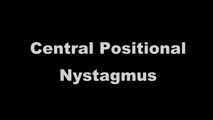 |
Positional Downbeat Nystagmus Mimicking Anterior Canal BPPV | Although positional downbeat nystagmus (pDBN) can indicate the rare anterior canal variant of benign paroxysmal positional vertigo, central mimics are common causes of pDBN. pDBN may be seen in multiple system atrophy (MSA), or seen with posterior fossa lesions, with a common example being a stroke ... | Image/MovingImage |
| 10 |
 |
Downbeat Nystagmus | 𝗢𝗿𝗶𝗴𝗶𝗻𝗮𝗹 𝗗𝗲𝘀𝗰𝗿𝗶𝗽𝘁𝗶𝗼𝗻: This is a 40-year-old man with 2 years of progressive ataxia and oscillopsia. On examination, he had downbeat nystagmus (DBN), an ocular motor finding that is usually (but not always) associated with flocculus/parafloccul... | Image/MovingImage |
| 11 |
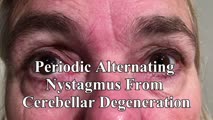 |
Periodic Alternating Nystagmus and Perverted Head-shaking Nystagmus in Cerebellar Degeneration | 𝗢𝗿𝗶𝗴𝗶𝗻𝗮𝗹 𝗗𝗲𝘀𝗰𝗿𝗶𝗽𝘁𝗶𝗼𝗻: This is a 60-yo-woman with several years of worsening imbalance, diplopia (hers was actually unrelated to cerebellar pathology [although she did have an esotropia greater at distance that was cerebellar in origin] and due... | Image/MovingImage |
| 12 |
 |
Square Wave Jerks and Macrosaccadic Oscillations in a Patient with a Cerebellar Tumor | This is a 40-year-old man who developed severe headaches, confusion, and gait imbalance which led to neuroimaging which demonstrated a midline cerebellar mass with compression of the fourth ventricle and obstructive hydrocephalus. He underwent a suboccipital craniectomy for resection of the mass, an... | Image/MovingImage |
| 13 |
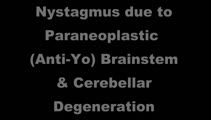 |
Nystagmus Due to Paraneoplastic (Anti-Yo) Brainstem and Cerebellar Degeneration | 𝗢𝗿𝗶𝗴𝗶𝗻𝗮𝗹 𝗗𝗲𝘀𝗰𝗿𝗶𝗽𝘁𝗶𝗼𝗻: This is a 40-yo-woman with anti-Yo antibody associated with ovarian cancer. Initial symptoms 2.5 years prior (to this video) included imbalance and dysarthria. She complained of oscillopsia which was due to her upbeat nys... | Image/MovingImage |
| 14 |
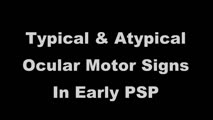 |
Atypical Ocular Motor Features (Gaze-evoked Nystagmus) in PSP | This is a 70-yo-woman who met clinical and radiologic diagnostic criteria for progressive supranuclear palsy (PSP). Typical ocular motor features of PSP include square wave jerks, hypometric saccades, choppy pursuit/VORS, impaired down>upgaze (supranuclear in origin) and impaired down>upward saccade... | Image/MovingImage |
| 15 |
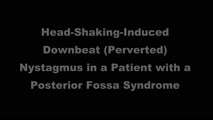 |
Downbeat (Perverted) Head Shaking Nystagmus in a Patient with Spontaneous Torsional Nystagmus | 𝗢𝗿𝗶𝗴𝗶𝗻𝗮𝗹 𝗗𝗲𝘀𝗰𝗿𝗶𝗽𝘁𝗶𝗼𝗻: This is a 75-year-old woman with vascular risk factors who experienced abrupt onset imbalance and dizziness. Symptoms were maximal at onset, and she denied progression over 6 months. Clinically, it was felt that she had s... | Image/MovingImage |
| 16 |
 |
Ocular Motor Signs of Cerebellar Ataxia - Gaze-Evoked Nystagmus, Saccadic Pursuit, and VOR Supression | 𝗢𝗿𝗶𝗴𝗶𝗻𝗮𝗹 𝗗𝗲𝘀𝗰𝗿𝗶𝗽𝘁𝗶𝗼𝗻: This is a 30-year-old woman with a several year long history of imbalance due to cerebellar ataxia of unclear etiology. Seen in this video are common ocular motor signs in patients with advanced cerebellar dysfunction inc... | Image/MovingImage |
| 17 |
 |
Upbeat Nystagmus & Ocular Flutter Due to Cerebellar Pilocytic Astrocytoma | This is a 20-year-old woman who was diagnosed with a cerebellar pilocytic astrocytoma at age 10 after presenting with severe headaches and hydrocephalus. She underwent incomplete resection and radiation therapy at that time. She experienced mild vertical oscillopsia in upgaze at baseline, and increa... | Image/MovingImage |
| 18 |
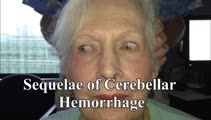 |
Sequelae of Cerebellar Hemorrhage - Gaze-evoked Nystagmus, Alternating Skew Deviation and Palatal Tremor | This is a 75-yo-woman presenting with a gait disorder. Two years prior, she suffered a cerebellar hemorrhage. On examination, there were typical cerebellar ocular motor signs including gaze-evoked nystagmus, choppy smooth pursuit and VOR suppression, and saccadic dysmetria. There was also an alterna... | Image/MovingImage |
| 19 |
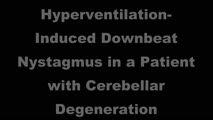 |
Hyperventilation-Induced Downbeat Nystagmus in a Cerebellar Disorder | 𝗢𝗿𝗶𝗴𝗶𝗻𝗮𝗹 𝗗𝗲𝘀𝗰𝗿𝗶𝗽𝘁𝗶𝗼𝗻: This is a 45-year-old woman with a chronic progressive cerebellopathy of unclear etiology (worsening over at least 10 years) characterized by gait and limb ataxia, gaze-evoked nystagmus, saccadic pursuit and vestibulo-ocu... | Image/MovingImage |
| 20 |
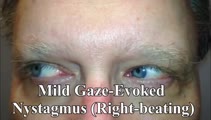 |
Rebound Nystagmus | This is a 50-yo-man who presented for dizziness and imbalance. His exam demonstrated choppy smooth pursuit and VOR suppression as well as mild gait ataxia. There was mild right-beating nystagmus in right gaze and left-beating nystagmus in left gaze without vertical gaze-evoked nystagmus. Occasionall... | Image/MovingImage |
| 21 |
 |
Test Your Knowledge: The Acute Vestibular Syndrome with Gaze-Evoked Nystagmus and Bilaterally Abnormal Head Impulse Testing Due to Middle Cerebellar Peduncle and Flocculus Hemorrhage | This is a 70-year-old woman with a history of atrial fibrillation on warfarin presenting with acute prolonged vertigo and imbalance. In addition to the findings demonstrated in the first part of the video, what else should be seen to reassure the examiner that the etiology of her vertigo is benign? ... | Image/MovingImage |
| 22 |
 |
Gaze-evoked and Rebound Nystagmus in a Cerebellar Syndrome | 𝗢𝗿𝗶𝗴𝗶𝗻𝗮𝗹 𝗗𝗲𝘀𝗰𝗿𝗶𝗽𝘁𝗶𝗼𝗻: 30-yo-man with the subacute onset of a cerebellar syndrome. After extensive evaluation and progression, it was thought that this represented an autoimmune process and there was some improvement with immunosuppression. He ... | Image/MovingImage |
| 23 |
 |
Torsional Jerk Nystagmus | Presented here are 3 patients with torsional jerk nystagmus. The first patient presented with vertigo and experienced oscillopsia due to her torsional nystagmus. Pure or predominantly torsional nystagmus is highly suggestive of a central process. Her nystagmus was unidirectional and followed Alexand... | Image/MovingImage |
| 24 |
 |
Test Your Knowledge - Central and Peripheral Vestibular and Ocular Motor Signs Due to a Large Vestibular Schwannoma | Which of the following is least likely to be the correct localization or etiology given the findings seen in the video? 1) Acute right 8th cranial neuropathy 2) Right-sided vestibular schwannoma 3) Right vestibular nucleus infarction 4) Right anterior inferior cerebellar artery distribution stroke A... | Image/MovingImage |
| 25 |
 |
Sagging Eye Syndrome and Cerebellar Disease in Divergence Insufficiency | 𝗢𝗿𝗶𝗴𝗶𝗻𝗮𝗹 𝗗𝗲𝘀𝗰𝗿𝗶𝗽𝘁𝗶𝗼𝗻: This is a 70-year-old woman who presented with diplopia at distance. Her exam demonstrated orthophoria at near with a fairly comitant 8-10 PD esotropia at distance without abduction paresis, consistent with divergence ins... | Image/MovingImage |
